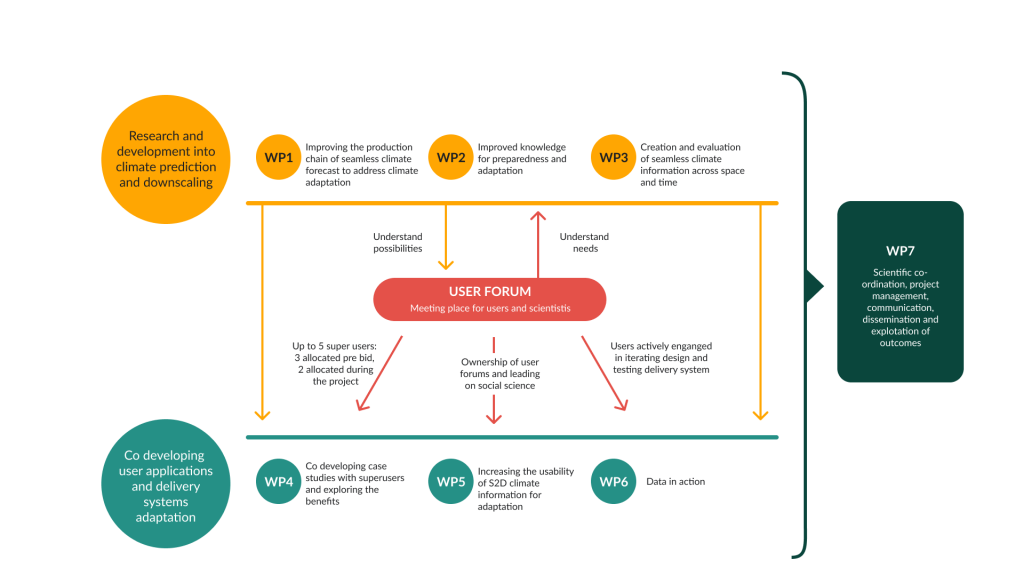Objectives
Objective #1
Improving seasonal-to-decadal (S2D) forecasts, where improvements are targeted on user-driven metrics
We have designed a timeline and user interaction schedule that will enable improvements to be targeted on user-driven metrics of high societal relevance, leading to modelling systems exploiting more of the potential predictability of the climate system. An important element is to make progress on understanding and taking account of the signal-to-noise (S/N) paradox in applications. This is a fundamental issue in making skilful climate predictions to which ASPECT seeks to develop the science, allowing us to harness more of the potential predictability of the climate system, and close the gap between current skill and potential predictability
Objective #2
Pioneering new extended initialised forecasts up to 30 years ahead
Pioneering a method for producing information from a season to more than a decade ahead using new extended initialised forecasts to 30 years. Extending initialised forecasts out to several decades carries the potential of truly seamless predictions starting from an initial state that is compatible with current observations. However, this comes with various challenges, such as how to deal with model drifts. This research will establish a currently missing, novel methodology, while the performance of these forecasts will be compared with merging products from different systems and for different forecast horizons, thus assessing whether the extended initialised forecasts can provide better information for user applications.
Objective #3
Pioneering new approaches to join the best forecasts on seasonal / 1–5-year / 5–30-year time-scales together
Pioneering new approaches to join the best forecasts on seasonal / 1–5-year / 5–30-year time-scales together and making those predictions actionable, aligning and applying them to the immediate needs of end-users.
A second approach to produce seamless climate prediction information over a period out to 30 years is to combine information from different systems on different time-scales, using joining/stitching, constraining and sub-selection methods. The added value in this approach will be explicitly assessed, both to individual case study users and to wider society.
Objective #4
Designing and implementing new ways to extract high-resolution information on extremes
Improved provision of methods to extract extreme events on scales relevant to adaptation will enable improved adaptation decision making. Also, the uncertainty accompanying the prediction and representation of extremes, regarding the intensity and frequency of hazards, will be thoroughly assessed, accounting for different sources of uncertainty, including limitations arising from model deficiencies (biases, limited resolution, under-represented physical processes, etc) with the aim of reducing the deficiencies where possible.
Objective #5
Exploring how users can get value from considering information on seasonal / 1–5-year / 5– 30-year time-scales together to improve decision making
Exploring for the first time how users can get value from considering seamless climate information on seasonal all the way through to 30-year time-horizon in order to improve decision making and adaptation, potentially accounting for relevant climate impacts and user vulnerability or adaptation tipping points. Whilst it is well known that resilience and adaptation decisions are made on various time-horizons in the period out to 30 years ahead, much less is known about how users can best make use of seamless climate information and the degree to which this information requires the predictions to be completely seamless rather than simply consistent.
Objective #6
Designing and implementing a delivery system for the data and methods produced
Designing and implementing delivery and dissemination for the data, methods and knowledge produced by ASPECT, enabling the scaling up of the use of climate risk information on the 1–30-year time-scale from beyond a few pilot studies to become a mainstream tool in adaptation. To go beyond pilots, ASPECT will produce a delivery system aligned to the very widely used C3S Climate Data Store (CDS), with workflows to implement methods applicable to the data generated during the project. Following a systematic skill assessment, new opportunities for developing climate services will be documented for different sectors. National meteorological services (NMSs) and users will inform the design of these workflows so they can be better tailored.

